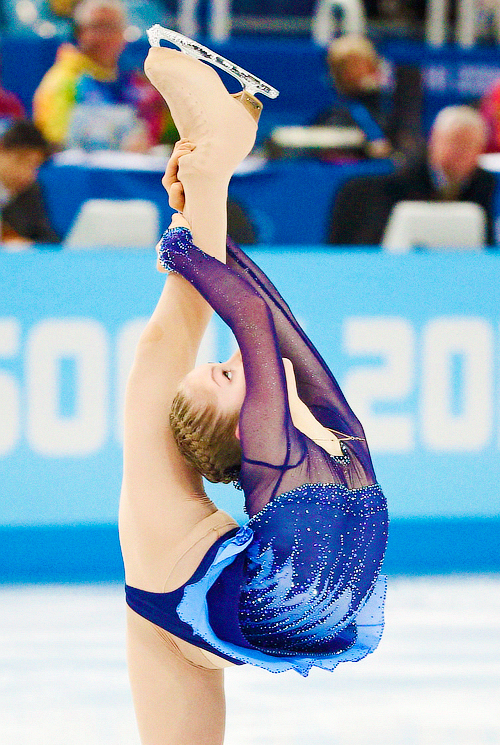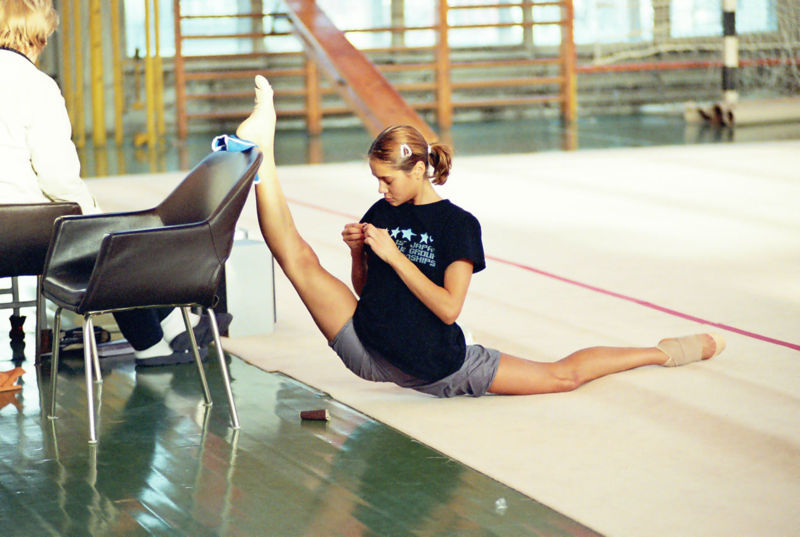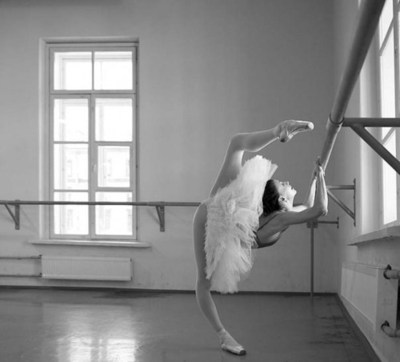Stretching: 5 Big Things to Know
Puppies doing yoga. Image source
Stretching. You hear it's good for you, that you should do it to take care of your joints, so you don't get stiff, etc etc etc.
This seemingly simplistic thing is actually far more complex than a simple sit and reach for your toes, and it doesn't help matters that every other trainer, instructor, and physical therapist is saying something different.
But here are 5 of the most important things that everyone should be aware of when approaching stretching.
For the record, I am writing this article using simplified terms and metaphors to drive the general point home and not bore you with nerd jargon and excessive details. Everything in fitness is so detailed with a million addendums to facts and can be discussed for hours upon end, but I want to try to streamline and simplify the most important points. This is not an end all/be all rulebook, and every person has different needs.
1. Flexibility vs. Mobility: It's not the same thing.
This is THE most important point out of this whole article.
When I meet with a new client for an initial assessment, one of the most common things I hear is, "I want to get more flexible" or "I want to improve my flexibility."
I would say about 90% of the time, what the client means is they want more mobility. They'll try to show me by bending over to do a toe touch, and they're like, "ahh I'm so inflexible, I can't touch my toes!" Well yes, your hamstrings may be tight- but for a large majority of the population, it's much more about hip mobility they lack.
This is...a mild ouch. Cartoon lady demonstrating poor hip mobility, moving through/rounding her lower back instead to touch the floor. Ouchies. Your lower back should not look like a camel hump, FYI. Image source
What is the difference between the two?
Most simply put: mobility refers to the ability to move through a joint, whereas flexibility refers to a connective tissue (in this case, we'll talk muscle primarily)'s ability to temporarily elongate. Best analogy I can make is a Chinese fingertrap- the actual length of the material doesn't change, but you can stretch it then shorten (contract) it. Also, note that I said temporarily- I've said this in another article, but it is physiologically impossible to "lengthen" your muscles (so you look leeeeean and toooooned... cough). Why is it impossible? Both ends of a muscle connect to bone at a joint. Bone, as in, unmovable/unlengthen-able bone. So asking to lengthen your muscles is like saying you want to grow taller through exercise- you can't. Trust me, if I could, I'd make myself tall enough to at least reach my kitchen cabinets without a stool.
Eat my foot? No problem. Image source
Pretty much everyone is born with near-perfect mobility. Just look at that baby to the right- he can put both of his feet behind his ears no problem, and squat perfectly to pick up his toy.
But life essentially messes us up. We sit in chairs for 12-hour work days with our shoulders rounded (goodbye hip, shoulder, and tspine mobility- sitting really is the enemy), and we wear high heels (goodbye ankle mobility).
Things like your hips, shoulders, thoracic spine (tspine/"upper back"), and ankles are built to move. But when those joints lose mobility through life, our other joints more built for stability like your c-spine (neck area, you know, to hold your head up), lumbar spine (lower back), and knees decide to be superheroes and pitch in with helping you move.
But that's not a good thing- how often do you see people reaching for a pillow for lumbar support (time to strengthen your core/work on your tspine mobility, buddy!), or complain about how they have "bad knees." Chances are, the root of the issue is not your lower back or knees. It's that your hips and tspine decided to stop helping you move.
2. Not everyone needs to be or should be gumby flexible.
Those pictures above are not normal. At all.
Let me be clear- these ladies, as awe-inspiring as they are, are demonstrating contortions of the body that is for a sport-specific purpose because their careers rely on movement like this. Your everyday woman (or man) should not be forcing themselves into a pretzel- unless your goal in life is to work for Cirque du Soleil.
Casual twist. Image source
I have been extremely mobile & flexible my whole life-this came in prime use for my skating career. I could do extreme positions like that photo on the top left without breaking a sweat and my nickname was Gumby. It was lauded as an extreme talent and something to be grateful for.
Well. Being so mobile but not owning the control over all of it while doing an extreme sport is definitely a main contributing factor in the number of injuries I've had, which is more than most football players I know. I really mean it when I say everything hurts when it rains!
Not everyones bodies are built the same way, nor our bones and joints in particular. Someone like me with a hip impingment (just the way my bones were built and very very common amongst the general population) should not be pushing my hip past certain ranges of movement- doing so essentially smacks bone into bone (hello arthritis).
Let me state something clearly: I love yoga. Love it so much, as has immense mental benefits as well as physical; HOWEVER- one of the goals and popular marketing points for yoga is to "improve flexibility." But for someone who isn't necessarily built to be quite flexible, shoving themselves into a bind and holding for a good 20 seconds, is just plain not okay.
There has been a sharp, spiked increase in hip and spinal injuries that coincide with the widespread practice of yoga- or shall I say, the improper instruction and regulation of it. The New York Times and Huffington Post both featured really great articles detailing this phenomenon further.
3. Stretching something that always feels "tight" or going really far into it because you don't "feel it" might be ignoring a yellow flag.
I'm stepping into a sticky territory here, as this is a bit more specific and not so generally applicable, but I wish I had known this when I was younger and before some other injuries.
Your body is insanely smart. Like it knows things before your brain can even figure out what's going on.
Everyone has muscular imbalances- that's pretty normal. But when they get out of control, that's when injury happens. But a tiny yellow flag that waves before an injury becomes full-blown glaring red flag is usually something people don't even notice.
Sasha Cohen's hammies are super tight, poor girl so inflexible!!!! Image source
If a muscle, let's say in this case your hamstring, feels extra tight and doesn't go away for awhile but it just feels so gooood to stretch so you just keep on stretching and stretching. Because it feels better and "loosened up" after stretching, right? Well that hamstring of yours might be tightening up on purpose to protect itself or some other issue that might be going on. Your body might be trying to put a shield up but you keep punching through it by overstretching.
And this last part of this bullet point is for all my skaters, dancers, and gymnasts out there: we are the queens of saying "ahh my hamstring feels so tight" while your foot is by your head and you could untie your shoelaces with your teeth. At that point, stretching is maybe not entirely necessary to help you "loosen up" (oh, the blasphemy!!!!!!)- you may benefit more from myofascial work and foam rolling.
4. Bouncing = No no no no no no no no no.
Bouncing mid-static stretch is definitely something I instinctively cringe at seeing.
Imagine your muscle as being this trampoline. This dude about to jump on it is akin to your bouncing. Image source
When you jump on a trampoline, you know how every time you land, you can usually hear the springs stretch and you make a dent in the trampoline only to spring back up?
Well, your muscle is the black material of the trampoline and the springs represent your connective tissue (tendons and ligaments) that help secure everything where it needs to be. By bouncing while stretching, you're effectively increasing risk of a connective tissue tear or overstretch- I don't think anyone wants that.
Also, muscles have a natural protective reflex. Ever feel that when you stretch and go right for it, you naturally tense up sharply but then after a few seconds of breathing and "sinking into" the stretch, you can go a little further?
That initial tension is your body's way of making sure you're not overstretching in a counterproductive way. This is a good thing. Don't push recklessly past it- you're not doing yourself any benefit that way.
5. Static stretching is best reserved for last.
By this I mean, that it's not ideal to static stretch before you work out.
What does that mean? Don't sit in a stretch for more than about 15 seconds before you decide to do a workout on it. This is a pretty well-known rule now in the fitness world, but it still isn't as well known as it should be.
There has been a significant amount of research on the decrease of athletic performance after stretching. Rather than link twenty articles to boring (well, not boring to me) research you won't read, let me put it this way:
Image source
A muscle does two primary things: it contracts, and it relaxes. A stretch is meant to relax the muscle, so the fibers can elongate. When you do any movement (walk, pick up a dumbell, pick up your kid, open a door), muscles contract so that you can exert strength. Don't you think that stretching out a spring and holding it for 20 seconds will remove some of its elasticity and ability to tightly bounce back?
We've all had the sad experience of ruining a Slinky as a kid because we pulled it a little too far.
In conclusion: there are a million ways to stretch.
And a million ways you shouldn't stretch. There are a million different stretching positions. There are dozens of methods of stretching.
But don't let this intimidate you! Knowledge is empowerment- make sure you understand what you are doing to your body.
If you do not know how to properly stretch, and are just kind of randomly putting your body in positions that initially feel good and like its stretching things- please seek out the proper instruction from a credible trainer or instructor. You are saving your body a lot of toil in the long run.
Any questions/comments, would love to hear them. Always feel free to comment below or email me!










